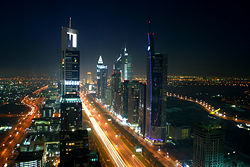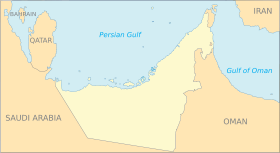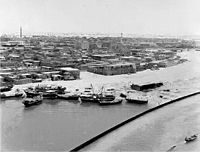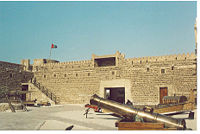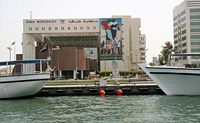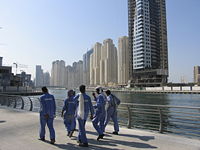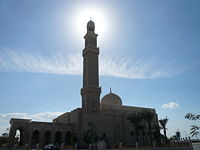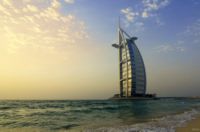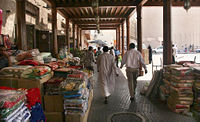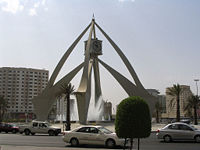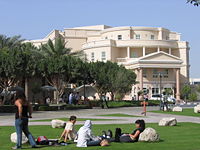Dubai
2008/9 Schools Wikipedia Selection. Related subjects: Middle Eastern Countries
| Dubai إمارة دبيّ |
|||
| — Emirate — | |||
| Emirate of Dubai | |||
| Dubai's Sheikh Zayed Road at night | |||
|
|||
| Location of Dubai in the UAE | |||
| Coordinates: | |||
|---|---|---|---|
| Country | United Arab Emirates | ||
| Emirate | Dubai | ||
| Incorporated (town) | June 9, 1833 | ||
| Incorporated (emirate) | December 2, 1971 | ||
| Founder | Maktoum bin Bati bin Suhail (1833) | ||
| Seat | Dubai | ||
| Subdivisions |
Towns and villages
|
||
| Government | |||
| - Type | Constitutional monarchy | ||
| - Emir | Mohammed bin Rashid Al Maktoum | ||
| - Crown Prince | Hamdan bin Mohammed bin Rashid Al Maktoum | ||
| Area | |||
| - Emirate | 4,114 km² (1,588.4 sq mi) | ||
| - Metro | 1,287.4 km² (497.1 sq mi) | ||
| Population (2008) | |||
| - Emirate | 2,261,995 | ||
| - Density | 408.18/km² (1,057.2/sq mi) | ||
| - Metro | 2,261,995 | ||
| - Nationality | 42.3% Indian 17% Emirati 13.3% Pakistani 9.1% Arab (other) 7.5% Bangladeshi 10.8% Others |
||
| Time zone | UAE standard time ( UTC+4) | ||
| Website: Dubai Emirate Dubai Municipality |
|||
Dubai (in Arabic: دبيّ, transliteration: dubaīy) can either refer to an emirate (one of seven) in the United Arab Emirates (UAE) in the eastern Arabian Peninsula, or that emirate's main city, sometimes called "Dubai city" to distinguish it from the emirate.
Written accounts documenting the existence of the city have existed at least 150 years prior to the formation of the UAE. Dubai shares legal, political, military and economic functions with the other emirates within a federal framework, although each emirate has jurisdiction over some functions such as civic law enforcement and provision and upkeep of local facilities. Dubai has the largest population and is the second largest emirate by area, after Abu Dhabi. Dubai and Abu Dhabi are the only two emirates to possess veto power over critical matters of national importance in the country's legislature. Dubai has been ruled by the Al Maktoum dynasty since 1833. The emirates' current ruler, Mohammed bin Rashid Al Maktoum, is also the Prime Minister and Vice President of the UAE.
A majority of the emirate's revenues are from trade, manufacturing and financial services. Revenues from petroleum and natural gas contribute less than 6% (2006) of Dubai's US$ 37 billion economy (2005). Dubai has attracted world-wide attention through innovative real estate projects and sports events. This increased attention, coinciding with its emergence as a world business hub, has also highlighted human rights issues concerning its largely foreign workforce.
Etymology
In the 1820s, Dubai was referred to as Al Wasl by British historians. However, few records pertaining to the cultural history of the UAE or its constituent emirates exist due to the region's vocal traditions in recording and passing down folklore and myth. The linguistic origins of the word Dubai are also in dispute, as some believe it to have originated from Persian, while some believe that Arabic is the linguistic root of the word. According to Fedel Handhal, researcher in the history and culture of the UAE, the word Dubai may have come from the word Daba (a derivative of Yadub), which means to creep; the word may be a reference to the flow of Dubai Creek inland.
History
Very little is known about pre-Islamic culture in the south-east Arabian peninsula, except that many ancient towns in the area were trading centers between the Eastern and Western worlds. The remnants of an ancient mangrove swamp, dated at 7,000 years, were discovered during the construction of sewer lines near Dubai Internet City. The area had been covered with sand about 5,000 years ago as the coastline retreated inland, becoming a part of the city's present coastline. Prior to Islam, the people in this region worshiped Bajir (or Bajar). The Byzantine and Sassanian empires constituted the great powers of the period, with the Sassanians controlling much of the region. After the spread of Islam in the region, the Umayyad Caliph, of the eastern Islamic world, invaded south-east Arabia and drove out the Sassanians. Excavations undertaken by the Dubai Museum in the region of Al-Jumayra ( Jumeirah) indicate the existence of several artifacts from the Umayyad period. The earliest recorded mention of Dubai is in 1095, in the "Book of Geography" by the Andalusian-Arab geographer Abu Abdullah al-Bakri. The Venetian pearl merchant Gaspero Balbi visited the area in 1580 and mentioned Dubai (Dibei) for its pearling industry. Documented records of the town of Dubai exist only after 1799.
In the early 19th century, the Al Abu Falasa clan ( House of Al-Falasi) of Bani Yas clan established Dubai, which remained a dependent of Abu Dhabi until 1833. On 8 January 1820, the sheikh of Dubai and other sheikhs in the region signed the "General Maritime Peace Treaty" with the British government. However, in 1833, the Al Maktoum dynasty (also descendants of the House of Al-Falasi) of the Bani Yas tribe left the settlement of Abu Dhabi and took over Dubai from the Abu Fasala clan without resistance. Dubai came under the protection of the United Kingdom by the "Exclusive Agreement" of 1892, with the latter agreeing to protect Dubai against any attacks from the Ottoman Empire. Two catastrophes struck the town during the mid 1800s. First, in 1841, a smallpox epidemic broke out in the Bur Dubai locality, forcing residents to relocate east to Deira. Then, in 1894, fire swept through Deira, burning down most homes. However, the town's geographical location continued to attract traders and merchants from around the region. The emir of Dubai was keen to attract foreign traders and lowered trade tax brackets, which lured traders away from Sharjah and Bandar Lengeh, which were the region's main trade hubs at the time.
Dubai's geographical proximity to India made it an important location. The town of Dubai was an important port of call for foreign tradesmen, chiefly those from India, many of whom eventually settled in the town. Dubai was known for its pearl exports until the 1930s. However, Dubai's pearling industry was damaged irreparably by the events of the First World War, and later on by the Great Depression in the late 1920s. Consequently, the city witnessed a mass migration of people to other parts of the Persian Gulf. Since its inception, Dubai was constantly at odds with Abu Dhabi. In 1947, a border dispute between Dubai and Abu Dhabi on the northern sector of their mutual border, escalated into war between the two states. Arbitration by the British and the creation of a buffer frontier running south eastwards from the coast at Ras Hasian resulted in a temporary cessation of hostilities. However, border disputes between the emirates continued even after the formation of the UAE; it was only in 1979 that a formal compromise was reached that ended hostilities and border disputes between the two states. Electricity, telephone services and an airport were established in Dubai in the 1950s, when the British moved their local administrative offices from Sharjah to Dubai. In 1966 the town joined the newly independent country of Qatar to set up a new monetary unit, the Qatar/Dubai Riyal, after the deflation of the Gulf rupee. Oil was discovered in Dubai the same year, after which the town granted concessions to international oil companies. The discovery of oil led to a massive influx of foreign workers, mainly Indians and Pakistanis. As a result, the population of the city from 1968 to 1975 grew by over 300%, by some estimates.
On 2 December 1971 Dubai, together with Abu Dhabi and five other emirates, formed the United Arab Emirates after former protector Britain left the Persian Gulf in 1971. In 1973, Dubai joined the other emirates to adopt a uniform currency: the UAE dirham. In the 1970s, Dubai continued to grow from revenues generated from oil and trade, even as the city saw an influx of Lebanese immigrants fleeing the civil war in Lebanon. The Jebel Ali Free Zone, comprising the Jebel Ali port (reputedly the world's largest man made port) was established in 1979, which provided foreign companies unrestricted import of labour and export capital.
The Persian Gulf War of 1990 had a huge impact on the city. Economically, Dubai banks experienced a massive withdrawal of funds due to uncertain political conditions in the region. During the course of the 1990s, however, many foreign trading communities — first from Kuwait, during the Persian Gulf War, and later from Bahrain, during the Shia unrest, moved their businesses to Dubai. Dubai provided refueling bases to allied forces at the Jebel Ali free zone during the Persian Gulf war, and again, during the 2003 Invasion of Iraq. Large increases in oil prices after the Persian Gulf war encouraged Dubai to continue to focus on free trade and tourism. The success of the Jebel Ali free zone allowed the city to replicate its model to develop clusters of new free zones, including Dubai Internet City, Dubai Media City and Dubai Maritime City. The construction of Burj Al Arab, the world's tallest freestanding hotel, as well as the creation of new residential developments, were used to market Dubai for purposes of tourism. Since 2002, the city has seen an increase in private real estate investment in recreating Dubai's skyline with such projects as The Palm Islands, The World Islands and Burj Dubai. However, robust economic growth in recent years has been accompanied by rising inflation rates (at 11.2% as of 2007 when measured against Consumer Price Index) which is attributed in part due to the near doubling of commercial and residential rental costs, resulting in a substantial increase in the cost of living for residents.
Geography
Dubai is situated on the Persian Gulf coast of the United Arab Emirates and is roughly at sea level (16 m/52 ft above). The emirate of Dubai shares borders with Abu Dhabi in the south, Sharjah in the northeast, and the Sultanate of Oman in the southeast. Hatta, a minor exclave of the emirate, is surrounded on three sides by Oman and by the emirates of Ajman (in the west) and Ras Al Khaimah (in the north). The Persian Gulf borders the western coast of the emirate. Dubai is positioned at and covers an area of 4,114 km² (1,588 mi²).
Dubai lies directly within the Arabian Desert. However, the topography of Dubai is significantly different from that of the southern portion of the UAE in that much of Dubai's landscape is highlighted by sandy desert patterns, while gravel deserts dominate much of the southern region of the country. The sand consists mostly of crushed shell and coral and is fine, clean and white. East of the city, the salt-crusted coastal plans, known as sabkha, give way to a north-south running line of dunes. Farther east, the dunes grow larger and are tinged red with iron oxide. The flat sandy desert gives way to the Western Hajar Mountains, which run alongside Dubai's border with Oman at Hatta. The Western Hajar chain has an arid, jagged and shattered landscape, whose mountains rise to about 1,300 meters in some places. Dubai has no natural river bodies or oases; however, Dubai does have a natural inlet, Dubai Creek, which has been dredged to make it deep enough for large vessels to pass through. Dubai also has multiple gorges and waterholes which dot the base of the Western Al Hajar mountains. A vast sea of sand dunes cover much of southern Dubai, which eventually lead into the desert known as The Empty Quarter. Seismically, Dubai is in a very stable zone — the nearest seismic fault line, the Zargos Fault, is 120 km from the UAE and is unlikely to have any seismic impact on Dubai. Experts also predict that the possibility of a tsunami in the region is also minimal because the Persian Gulf waters are not deep enough to trigger a tsunami.
The sandy desert surrounding the city supports wild grasses and occasional date palm trees. Desert hyacinths grow in the sabkha plains east of the city, while acacia and ghaf trees grow in the flat plains within the proximity of the Western Al Hajar mountains. Several indigenous trees such as the date palm and neem as well as imported trees like the eucalypts grow in Dubai's natural parks. The houbara bustard, striped hyena, caracal, desert fox, falcon and Arabian oryx are common in Dubai's desert. Dubai is on the migration path between Europe, Asia and Africa, and more than 320 migratory birds pass through the emirate in spring and autumn. The waters of Dubai are home to more than 300 species of fish, including the hammour.
Dubai Creek runs northeast-southwest through the city. The eastern section of the city forms the locality of Deira and is flanked by the emirate of Sharjah in the east and the town of Al Aweer in the south. The Dubai International Airport is located south of Deira, while the Palm Deira is located north of Deira in the Persian Gulf. Much of Dubai's real estate boom is concentrated to the west of the Dubai Creek, on the Jumeirah coastal belt. Port Rashid, Jebel Ali, Burj Al Arab, the Palm Jumeirah and theme based free zone clusters such as Business Bay are all located in this section. Five main routes — E 11 (Sheikh Zayed Road), E 311 (Emirates Road), E 44 (Dubai-Hatta Highway), E 77 (Dubai-Al Habab Road) and E 66 (Oud Metha Road) — run through Dubai, connecting the city to other towns and emirates. Additionally, several important intra-city routes, such as D 89 (Al Maktoum Road/Airport Road), D 85 (Baniyas Road), D 75 (Sheikh Rashid Road), D 73 (Al Dhiyafa Road), D 94 (Jumeirah Road) and D 92 (Al Khaleej/Al Wasl Road) connect the various localities in the city. The eastern and western sections of the city are connected by Al Maktoum Bridge, Al Garhoud Bridge, Al Shindagha Tunnel, Business Bay Crossing and Floating Bridge.
Dubai has a hot and, at times, humid climate (drier during extreme heat) with many months recording temperatures of over 40 °C (104 °F) (refer to accompanying table for recorded mean minimum and maximum temperatures during the year). Rainfall is generally light, with a mean of about 150 millimetres (6 in) per year; precipitation is usually centered around January, February and March. However, heavy rain is not uncommon in Dubai during the winter months and January 2008 saw a record of 120mm (or 5") of rain falling in just 24 hours, The mean humidity in Dubai is about 60% and is higher during the cooler winter months.
| Weather averages for Dubai | |||||||||||||
|---|---|---|---|---|---|---|---|---|---|---|---|---|---|
| Month | Jan | Feb | Mar | Apr | May | Jun | Jul | Aug | Sep | Oct | Nov | Dec | Year |
| Average high °C (°F) | 24.0 (75) | 25.4 (78) | 28.2 (83) | 32.9 (91) | 37.6 (100) | 39.5 (103) | 40.8 (105) | 41.3 (106) | 38.9 (102) | 35.4 (96) | 30.5 (87) | 26.2 (79) | 33.4 (92) |
| Average low °C (°F) | 14.3 (58) | 15.4 (60) | 17.6 (64) | 20.8 (69) | 24.6 (76) | 27.2 (81) | 29.9 (86) | 30.2 (86) | 27.5 (82) | 23.9 (75) | 19.9 (68) | 16.3 (61) | 22.3 (72) |
| Rain Fall mm (inches) | 15.6 (0.61) | 25.0 (0.98) | 21.0 (0.83) | 07.0 (0.28) | 00.4 (0.02) | 00.0 (0) | 00.8 (0.03) | 00.0 (0) | 00.0 (0) | 01.2 (0.05) | 02.7 (0.11) | 14.9 (0.59) | 07.4 (0.29) |
| Source: Dubai Meteorological Office 13 April 2008 | |||||||||||||
Governance and politics
Dubai's government operates within the framework of a constitutional monarchy, and has been ruled by the Al Maktoum family since 1833. The current ruler, Mohammed bin Rashid Al Maktoum, is also the Prime Minister of the United Arab Emirates and member of the Supreme Council of the Union (SCU). Dubai appoints 8 members in two-term periods to the Federal National Council (FNC) of the UAE, the supreme federal legislative body. The Dubai Municipality (DM) was established by the then ruler of Dubai, Rashid bin Saeed Al Maktoum in 1954 for purposes of city planning, citizen services and upkeep of local facilities. DM is chaired by Hamdan bin Rashid Al Maktoum, deputy ruler of Dubai and comprises several departments such as the Roads Department, Planning and Survey Department, Environment and Public Health Department and Financial Affairs Department. In 2001, Dubai Municipality embarked on an e-Government project with the intention of providing 40 of its city services through its web portal (Dubai.ae). Thirteen such services were launched by October 2001, while several other services were expected to be operational in the future.
Dubai and Ras al Khaimah are the only emirates that do not conform to the federal judicial system of the United Arab Emirates. The emirate's judicial courts comprise the Court of First Instance, the Court of Appeal, and the Court of Cassation. The Court of First Instance consists of the Civil court, which hears all civil claims, the Criminal Court, which hears claims originating from police complaints, and Sharia Court, which is responsible for matters between Muslims. Non-Muslims do not appear before the Sharia Court. The Court of Cassation is the apex court of the emirate and only hears disputes on matters of law. The Dubai Police Force, founded in 1956 in the locality of Naif, has law enforcement jurisdiction over the emirate; the force is under direct command of Mohammed bin Rashid al Maktoum, ruler of Dubai.
Article 25 of the Constitution of the UAE provides for the equitable treatment of persons with regard to race, nationality, religious beliefs or social status. However, many of Dubai's 250,000 foreign laborers live in conditions described by Human Rights Watch as being "less than human." NPR reports that workers "typically live eight to a room, sending home a portion of their salary to their families, whom they don't see for years at a time." On 21 March 2006, workers at the construction site of Burj Dubai, upset over bus timings and working conditions, rioted: damaging cars, offices, computers, and construction tools. Judicial rulings in Dubai with regard to foreign nationals were brought to light by the alleged attempts to cover up information on the rape of Alexandre Robert, a 15 year old French-Swiss national, by three locals, one of whom was HIV positive and by the recent mass imprisonment of migrant laborers, most of whom were from India, on account of their protests against poor wages and living conditions. Prostitution, though illegal by law, is conspicuously present in the emirate because of an economy that is largely based on tourism and trade. Research conducted by the American Centre for International Policy Studies (AMCIPS) found that Russian and Ethiopian women are the most common prostitutes, as well as women from other African countries, while Indian prostitutes are part of a well organized trans-Oceanic prostitution network. A 2007 PBS documentary entitled Dubai: Night Secrets reported that prostitution in clubs is tolerated by authorities and many foreign women work there without being coerced, attracted by the money.
Demographics
| Year | Population |
| 18221 | 1,200 |
| 19001 | 10,000 |
| 19301 | 20,000 |
| 19401 | 38,000 |
| 19541 | 20,000 |
| 19601 | 40,000 |
| 1968 | 58,971 |
| 1975 | 183,000 |
| 1985 | 370,800 |
| 1995 | 674,000 |
| 2005 | 1,204,000 |
| 1 The town of Dubai first conducted a census in 1968. All population figures in this table prior to 1968 are estimates obtained from various sources. | |
According to the census conducted by the Statistics Centre of Dubai, the population of the emirate was 1,422,000 as of 2006, which included 1,073,000 males and 349,000 females. As of 1998, 17% of the population of the emirate was made up of UAE nationals. Approximately 85% of the expatriate population (and 71% of the emirate's total population) was Asian, chiefly Indian (51%), Pakistani (16%), Bangladeshi (9%) and Filipino (3%). About 3% of the total population of Dubai was categorized as " Western". A quarter of the population however reportedly traces their origins to neighboring Iran. In addition, 16% of the population (or 288,000 persons) lived in collective labour accommodation were not identified by ethnicity or nationality, but were thought to be primarily Asian. The median age in the emirate was about 27 years. The crude birth rate, as of 2005, was 13.6%, while the crude death rate was about 1%.
Although Arabic is the official language of Dubai, Hindi, Malayalam, Urdu, Persian, Tagalog, Bengali and other languages are spoken in Dubai. English is the lingua franca of the city and is widely spoken.
Article 7 of the UAE's Provisional Constitution declares Islam the official state religion of the UAE. The government subsidizes almost 95 percent of mosques and employs all imams; approximately 5 percent of mosques are entirely private, and several large mosques have large private endowments.
Dubai has large Hindu, Christian, Buddhist, Sikh and other religious communities. Non-Muslim groups can own their own houses of worship, where they can practice their religion freely, by requesting a land grant and permission to build a compound. Groups that do not have their own buildings must use the facilities of other religious organisations or worship in private homes. Non-Muslim religious groups are permitted to openly advertise group functions; however, proselytizing or distributing religious literature is strictly prohibited under penalty of criminal prosecution, imprisonment, and deportation for engaging in behaviour offensive to Islam.
Economy
Dubai's gross domestic product as of 2005 was US$37 billion. Although Dubai's economy was built on the back of the oil industry, revenues from oil and natural gas currently account for less than 6% of the emirate's revenues. It is estimated that Dubai produces 240,000 barrels of oil a day and substantial quantities of gas from offshore fields. The emirate's share in UAE's gas revenues is about 2%. Dubai's oil reserves have diminished significantly and are expected to be exhausted in 20 years. Trade (16%), entrepôt (15%) and financial services (11%) are the largest contributors to Dubai's economy. Dubai's top re-exporting countries include Iran (US$ 790 million), India (US$ 204 million) and Saudi Arabia (US$ 194 million). The emirate's top importing countries are Japan (US$ 1.5 billion), China (US$ 1.4 billion) and the United States (US$ 1.4 billion).
Historically, Dubai and its twin across the Dubai creek, Deira (independent of Dubai City at that time), became important ports of call for Western manufacturers. Most of the new city's banking and financial centres were headquartered in the port area. Dubai maintained its importance as a trade route through the 1970s and 1980s. Dubai has a free trade in gold and until the 1990s, was the hub of a "brisk smuggling trade" of gold ingots to India, where gold import was restricted.
The Jebel Ali port in Dubai, constructed in the 1970s, has the largest man-made harbour in the world and was ranked eighth globally for the volume of container traffic it supports . Dubai is also developing as a hub for service industries such as IT and finance, with the establishment of industry-specific free zones throughout the city. Dubai Internet City, combined with Dubai Media City as part of TECOM (Dubai Technology, Electronic Commerce and Media Free Zone Authority) is one such enclave whose members include IT firms such as EMC Corporation, Oracle Corporation, Microsoft, and IBM, and media organisations such as MBC, CNN, Reuters and AP.
The Dubai Financial Market (DFM) was established in March 2000 as a secondary market for trading securities and bonds, both local and foreign. As of fourth quarter 2006, its trading volume stood at about 400 billion shares, worth US$ 95 billion in total. The DFM had a market capitalisation of about US$ 87 billion. The government's decision to diversify from a trade-based, but oil-reliant, economy to one that is service and tourism-oriented has made real estate more valuable, resulting in the property appreciation from 2004–2006. Large scale real estate development projects have led to the construction of some of the tallest skyscrapers and largest projects in the world such as the Emirates Towers, the Burj Dubai, the Palm Islands and the world's tallest, and most expensive, hotel the Burj Al Arab.
Transportation
Dubai International Airport ( IATA: DXB), the hub for Emirates Airline, services the city of Dubai and other emirates in the country. The airport served a total of over 34 million passengers and over 260,000 flights in 2007. The Dubai International Airport ranked 17th among international airports for total cargo traffic in 2006. A third terminal and a new concourse are currently under construction and are both due to open in mid-2008. The new terminal will be dedicated to Emirates Airline and will fully support the new Airbus A380. The development of Dubai World Central International Airport, currently under construction in Jebel Ali, was announced in 2004. The first phase is expected to be completed by 2008, and once operational the new airport will host foreign airlines. Emirates (both the passenger and cargo operations) will remain in Dubai International Airport.
Dubai has a large bus system that services 69 routes and transported over about 90 million people in 2006. The Road and Transport Authority (RTA) announced in 2006 that an additional 620 new buses will be added to its fleet of 170 double decker buses. Although the main mode of transportation in Dubai is by private vehicle, Dubai also has an extensive taxi system.
A $3.89 billion Dubai Metro project is under construction for the emirate. The Metro system is expected to be partially operational by 2009 and fully operational by 2012. The metro will comprise two lines: the Green Line from Al Rashidiya to the main city centre and the Red Line from the airport to Jebel Ali. The Dubai Metro (Green and Blue Lines) will have 70 kilometers of track and 43 stations, 33 above ground and ten underground. One of the more traditional methods of getting across Bur Dubai to Deira is through abras, small boats that ferry passengers across the Dubai Creek, between abra stations in Bastakiya and Baniyas Road.
In July 2007, the Salik road toll network was installed on Sheikh Zayed Road and on Al Garhoud bridge; the tolling stations are fully automated and collect toll of AED 4 (US$ 1.08) per transit.
Culture
Dubai has a diverse and multicultural society. The city's cultural imprint as a small, ethnically homogenous pearling community was changed with the arrival of other ethnic groups and nationals — first by the Iranians in the early 1900s, and later by Indians and Pakistanis in the 1960s. Despite the diversity of the population, only minor and infrequent episodes of ethnic tensions, primarily between expatriates, have been reported in the city. In 1994, Hindu and Muslim labourers clashed over the destruction of the Babri Masjid in Ayodhya, India, which resulted in the detainment and deportation of hundreds of Indian and Pakistani workers . Major holidays in Dubai include Eid al Fitr, which marks the end of Ramadan, and National Day ( December 2), which marks the formation of the United Arab Emirates. Annual entertainment events such as the Dubai Shopping Festival (DSF) and Dubai Summer Surprises (DSS) attract over 4 million visitors from across the region and generate revenues in excess of US$ one billion . Large shopping malls in the city, such as Deira City Centre, BurJuman, Mall of the Emirates and Ibn Battuta Mall as well as traditional souks attract shoppers from the region.
The diversity of cuisine in Dubai is a reflection of the cosmopolitan nature of the society. Arab food is very popular and is available everywhere in the city, from the small shawarma diners in Deira and Al Karama to the upscale restaurants in Dubai's many hotels. Fast food, South Asian, Chinese cuisines are also very popular and are widely available. The sale and consumption of pork, though not illegal, is regulated and is sold only to non- Muslims, in designated areas. Similarly, the sale of alcoholic beverages is regulated. A liquor permit is required to purchase alcohol; however, alcohol is available in bars and restaurants within four or five star hotels. Shisha and qahwa boutiques are also popular in Dubai.
Hollywood and Bollywood movies are popular in Dubai. The city hosts the annual Dubai International Film Festival, which attracts celebrities from Arab and International cinema. Dubai has an active music scene, with musicians Amr Diab, Diana Haddad, Tarkan, Aerosmith, Santana, Elton John, Pink, Shakira, Celine Dion and Phil Collins having performed in the city. Madonna is rumored to play live in November for ₤7.5 million. .The Dubai Desert Rock Festival is also another major festival consisiting of Heavy metal and rock artists.
Football and cricket are the most popular sports in Dubai. Five teams — Al Wasl, Al-Shabab, Al-Ahli, Al Nasr and Hatta — represent Dubai in UAE League football. Current champions Al-Wasl have the second-most number of championships in the UAE League, after Al Ain. Cricket is followed by Dubai's large South Asian community and in 2005, the International Cricket Council (ICC) moved its headquarters from London to Dubai. The city has hosted several India-Pakistan matches and two new grass grounds are being developed in Dubai Sports City. Dubai also hosts both the annual Dubai Tennis Championships and The Legends Rock Dubai tennis tournaments, as well as the Dubai Desert Classic golf tournament, all of which attract sports stars from around the world. The Dubai World Cup, a thoroughbred horse race, is held annually at the Nad Al Sheba Racecourse.
Dubai is known for its nightlife. Clubs and bars are found mostly in hotels due to the liquor laws. The New York Times listed Dubai as its travel choice for partying in 2008.
Education
The school system in Dubai does not differ from that of the United Arab Emirates. As of 2006, there are 88 public schools run by the Ministry of Education that serve Emiratis and expatriate Arabs as well as 132 private schools. The medium of instruction in public schools is Arabic with emphasis on English as a second language, while most of the private schools use English as their medium of instruction. Most private schools cater to one or more expatriate communities. Delhi Private School, Our Own English High School, the Dubai Modern High School, and The Indian High School, Dubai offer either a CBSE or an ICSE Indian syllabus. Similarly, there are also several reputable Pakistani schools offering FBISE curriculum for expatriate children. Dubai English Speaking School, Jumeirah Primary School, Jebel Ali Primary School, the Cambridge High School (or Cambridge International School), Jumeirah English Speaking School, King's School and the Horizon School all offer British primary education up to the age of eleven. Dubai British School, Dubai College, English College Dubai, Jumeirah English Speaking School, Jumeirah College and St. Mary's Catholic High School are all British eleven-to-eighteen secondary schools which offer GCSE and A-Levels. Emirates International School provides full student education up to the age of 18, this is an International school and offers IGCSE and the IB program. Wellington International School, which caters education from 4-18, offers IGCSE and A-Levels. Deira International School also offers the IB program including the IGCSE program.
The Ministry of Education of the United Arab Emirates is responsible for school's accreditation. The Dubai Education Council was established in July 2005 to develop the education sector in Dubai. The Knowledge and Human Development Authority (KHDA) was established in 2006 to develop education and human resource sectors in Dubai, and license educational institutes.
Approximately 10% of the population has university or postgraduate degrees. Many expatriates tend to send their children back to their home country or to Western countries for university education and even to India for technology studies. However, a sizable number of foreign accredited universities have been set up in the city over the last ten years. Some of these universities include Michigan State University Dubai (MSU Dubai), the Birla Institute of Technology & Science, Pilani - Dubai( BITS Pilani), Heriot-Watt University Dubai, American University in Dubai (AUD), the American College of Dubai, Mahatma Gandhi University (Off-Campus Centre), SP Jain Centre Of Management, University of Wollongong in Dubai, Institute of Management Technology and MAHE Manipal. In 2004, the Dubai School of Government in collaboration with Harvard University's John F. Kennedy School of Government and Harvard Medical School Dubai Centre (HMSDC) were established in Dubai.
